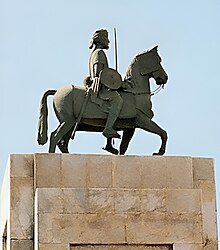| Ahmad ibn Ibrahim al-Ghazi أحمد بن إبراهيم الغازي | |
|---|---|
| Imam | |
 | |
| Leader of Adal | |
| Reign | c. 1527 – 21 February 1543 |
| Predecessor | Abu Bakr ibn Muhammad |
| Successor | Nur ibn Mujahid |
| Born | c. 1506 Hubat, Adal Sultanate |
| Died | 21 February 1543 (aged 36–37) Wayna Daga, Ethiopian Empire |
| Burial | |
| Spouse |
|
| Issue |
|
| Religion | Sunni Islam |
Ahmad ibn Ibrahim al-Ghazi (Arabic: أحمد بن إبراهيم الغازي, Harari: አሕመድ ኢብራሂም አል-ጋዚ, Somali: Axmed Ibraahim al-Qaasi;[2] c. 21 July 1506 – 10 February 1543) was the Imam of the Adal Sultanate from 1527 to 1543.[3] Commonly named Ahmed Gragn in Amharic and Gurey in Somali, both meaning the left-handed, he led the invasion and conquest of Abyssinia from the Sultanate of Adal during the Ethiopian-Adal War.[4] He is often referred to as the "King of Zeila" in medieval texts.[1]: 79
Dubbed "The African Attila" by Orientalist Frederick A. Edwards,[5]: 324 Imam Ahmed‘s conquests reached all the way to the borders of the Sultanate of Funj.[6][7] Imam Ahmed won nearly all his battles against the Ethiopians before 1541 and after his victory at Battle of Amba Sel, the Ethiopian Emperor, Dawit II was never again in a position to offer a pitched battle to his army[5]: 341 [8]: 329 and was subsequently forced to live as an outlaw constantly hounded by Imam Ahmed's soldiers, the Malassay.[9]
- ^ a b Cite error: The named reference
Whitewaywas invoked but never defined (see the help page). - ^ R. Michael Feener (2004). Islam in World Cultures: Comparative Perspectives. ABC-CLIO. p. 219. ISBN 9781576075166.
- ^ Saheed A. Adejumobi (2008). The History of Ethiopia. Greenwood Publishing Group. p. 178. ISBN 9780313322730. Archived from the original on 2023-04-08. Retrieved 2019-02-11.
- ^ The New Encyclopædia Britannica, Volume 1. Encyclopædia Britannica. 1998. p. 163. ISBN 9780852296639. Archived from the original on 2023-04-08. Retrieved 2019-02-11.
- ^ a b Cite error: The named reference
Edwardswas invoked but never defined (see the help page). - ^ Burton, Richard. First Footsteps in East Africa. p. 179.
- ^ Pal Ruhela, Satya; Farah Aidid, Mohammed (1994). Somalia: From The Dawn of Civilization To The Modern Times. Vikas Pub. House. ISBN 9780706980042.
- ^ Cite error: The named reference
Budgewas invoked but never defined (see the help page). - ^ Cite error: The named reference
Reidulfwas invoked but never defined (see the help page).